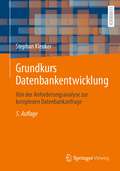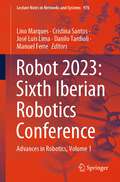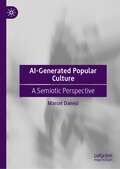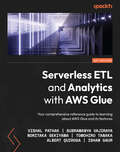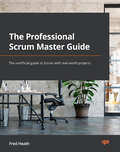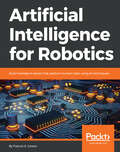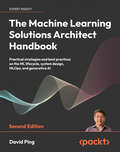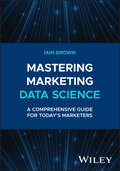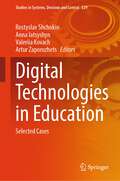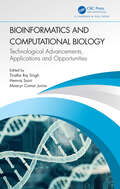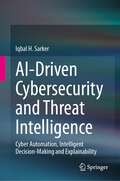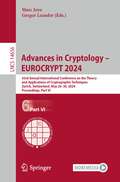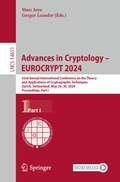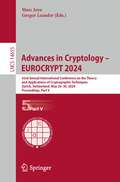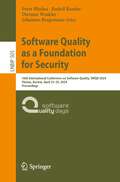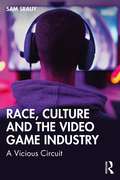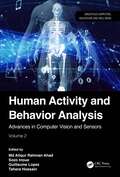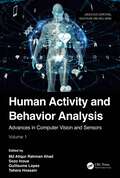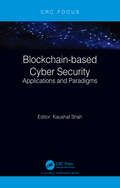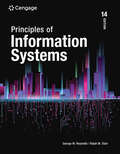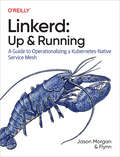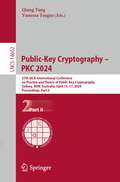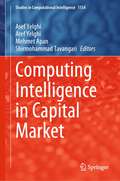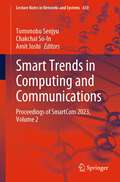- Table View
- List View
Grundkurs Datenbankentwicklung: Von der Anforderungsanalyse zur komplexen Datenbankanfrage
by Stephan KleukerMit diesem Buch erhalten Studierende einen kompakten und praxisorientierten Einstieg, mit dem sie bereits früh im Studium sehr gut zurechtkommen. Die verschiedenen Phasen einer Datenbankentwicklung werden mit ihren Vorgehensweisen, Konzepten und möglichen Problemquellen vorgestellt. Gerade die Anforderungsanalyse und die Möglichkeit zur Erstellung mächtiger SQL-Anfragen werden als besonders praxisrelevante Aspekte betont. Durch die im zweiten Teil detailliert vorgestellte Integration von Datenbanken in die umgebende Software sind Studierende nach der Lektüre in der Lage, in Praxisprojekten erfolgreich mitzuarbeiten. Das Buch deckt inhaltlich eine Einführungsvorlesung vollständig ab. Die 5. Auflage wurde um das Thema JPA (Objekt-Relationale-Persistenz), Trigger in Java ergänzt. Zusätzlich werden Unterschiede zwischen Oracle, Maria DB, SQLite und Apache Derby erläutert. Neben vielen kleinen Beispielen zur Verdeutlichung einzelner Aspekte wird ein durchgehendes Beispiel genutzt. Alle Kapitel schließen mit Wiederholungsfragen und Übungsaufgaben, deren Lösungen online zum Download zur Verfügung stehen.
Advancements in Urban Environmental Studies: Application of Geospatial Technology and Artificial Intelligence in Urban Studies (GIScience and Geo-environmental Modelling)
by Atiqur Rahman Shouraseni Sen Roy Swapan Talukdar ShahfahadAccording to UN estimates, approximately nearly half of the world's population now lives in cities and that figure is expected to rise to almost 70% by 2050. Cities now account for around 70% of worldwide greenhouse gas emissions, and this percentage is predicted to rise in the near future as a result of projected increases in global urbanization patterns. It is widely acknowledged that irrational urban planning and design can increase emissions while also exacerbating threats and risks, resulting in a slew of environmental issues such as urban heat islands, air pollution, flooding, amongst other issues, as well as environmental, social, and economic losses. Therefore, these concerns must be addressed promptly in order to cope up with these rising difficulties and make urban environments safer for residents. With the advancement of remote sensing technology and the use of current remote observation systems, urban data science, remote sensing, and artificial intelligence (AI), modeling and quantifying emergent difficulties in urban regions and urban systems have become easy. They aid in the quantitative analysis of urban shape, functions, and human behavior in cities. Harvesting data, developing models, and suggesting new methodologies will be aided by combining urban ecology with new breakthroughs in data science. This book is of great value to a diverse group of academicians, scientists, students, environmentalists, meteorologists, urban planners, remote sensing and GIS experts with a common interest in geospatial sciences within the earth environmental sciences, as well as human and social sciences.
Robot 2023: Advances in Robotics, Volume 1 (Lecture Notes in Networks and Systems #976)
by Lino Marques Cristina Santos José Luís Lima Danilo Tardioli Manuel FerreThis text will be replaced by the correct backcovertext / informationtext as soon as we get it.
AI-Generated Popular Culture: A Semiotic Perspective
by Marcel DanesiThis book gives a general overview of Artificial Intelligence as it is impacting on the world of the arts and culture. What is AI-generated pop culture? What does a movie, a musical work, a novel, or song created entirely by a generative AI imply in terms of our notions of creativity? What is the semiotic dynamic (the meaning-making impulse that humans imprint in sign and textual forms) that is involved in an AI-produced work? No comprehensive treatment exists of the profound implications that AI-generated pop culture entails, including how it might affect cultural evolution and how we interpret artistic artifacts. Such a treatment is critical at this moment, and this book aims to fill this gap.
Serverless ETL and Analytics with AWS Glue: Your comprehensive reference guide to learning about AWS Glue and its features
by Vishal Pathak Subramanya Vajiraya Noritaka Sekiyama Tomohiro Tanaka Albert QuirogaBuild efficient data lakes that can scale to virtually unlimited size using AWS GlueKey FeaturesLearn to work with AWS Glue to overcome typical implementation challenges in data lakesCreate and manage serverless ETL pipelines that can scale to manage big dataWritten by AWS Glue community members, this practical guide shows you how to implement AWS Glue in no timeBook DescriptionOrganizations these days have gravitated toward services such as AWS Glue that undertake undifferentiated heavy lifting and provide serverless Spark, enabling you to create and manage data lakes in a serverless fashion. This guide shows you how AWS Glue can be used to solve real-world problems along with helping you learn about data processing, data integration, and building data lakes.Beginning with AWS Glue basics, this book teaches you how to perform various aspects of data analysis such as ad hoc queries, data visualization, and real-time analysis using this service. It also provides a walk-through of CI/CD for AWS Glue and how to shift left on quality using automated regression tests. You'll find out how data security aspects such as access control, encryption, auditing, and networking are implemented, as well as getting to grips with useful techniques such as picking the right file format, compression, partitioning, and bucketing. As you advance, you'll discover AWS Glue features such as crawlers, Lake Formation, governed tables, lineage, DataBrew, Glue Studio, and custom connectors. The concluding chapters help you to understand various performance tuning, troubleshooting, and monitoring options.By the end of this AWS book, you'll be able to create, manage, troubleshoot, and deploy ETL pipelines using AWS Glue.What you will learnApply various AWS Glue features to manage and create data lakesUse Glue DataBrew and Glue Studio for data preparationOptimize data layout in cloud storage to accelerate analytics workloadsManage metadata including database, table, and schema definitionsSecure your data during access control, encryption, auditing, and networkingMonitor AWS Glue jobs to detect delays and loss of dataIntegrate Spark ML and SageMaker with AWS Glue to create machine learning modelsWho this book is forThis book is for ETL developers, data engineers, and data analysts who want to understand how AWS Glue can help you solve your business problems. Basic knowledge of AWS data services is assumed.
The Professional Scrum Master (PSM I) Guide: Successfully practice Scrum with real-world projects and achieve your PSM I certification with confidence
by Fred HeathGo from absolute beginner to passing your PSM I exam first time with this comprehensive guide. Packed with practical examples, this book is updated for the latest Scrum guidelines to turn you into a Scrum Master!Key FeaturesGo from absolute beginner to exam-ready with detailed explorations of Scrum use-casesUnderstand the different applications of agile concepts, and how to best apply them to your businessDiscover expert tips and work with real-world examples to pass the PSM I certification exam first timeBook DescriptionEver wondered why you'd use Scrum over other process frameworks? Or what makes Agile just so agile? Or why you should bother with the PSM certification? This book has you covered.The Professional Scrum Master (PSM I) Guide is a comprehensive tutorial that will not only introduce you to the basics of Scrum, but build you up to be ready to pass your PSM I exam first time round. Where other books avoid detail, this guide provides you with detailed practical examples to take you from being an apprentice to becoming a master.Assuming you're a total beginner, this book will introduce you to Scrum methodologies with detailed use cases, teaching you the secrets of Scrum in such a way that you'll be well-equipped for the PSM I exam.This book demonstrates the real-world applications of Scrum in a variety of scenarios, all with practical examples.You'll understand why the structure of your Scrum team matters, what you can achieve with properly planned sprints, and how to create and manage sprint and product backlogs. The chapters are regularly concluded with quizzes relevant to the exam, reinforcing the values you learn on your journey. Finally, it concludes with some exam preparation and myth-dispelling to make sure you have an edge when it comes to earning your certificate. This is a guide that'll ensure you won't fall behind in an ever increasingly agile world.What you will learnGet to grips with Agile development and Scrum from the ground upUnderstand the roles and responsibilities within the Scrum teamDiscover how to conduct Scrum events and create Scrum artifactsExplore real-world scenarios and use cases for Scrum in actionDevelop an in-depth understanding of how to run a successful sprint to deliver results quicklyBe fully prepared and able to pass your PSM I exam first timeWho this book is forAssuming no prior knowledge of Scrum, this book is for professionals who want to build a strong foundation in Scrum practices with the intention of passing the PSM I exam. If you're a product owner or project manager looking to stay relevant in an agile world, this book is essential to helping you become a Scrum Master.
Artificial Intelligence for Robotics: Build intelligent robots that perform human tasks using AI techniques
by Francis X. GoversBring a new degree of interconnectivity to your world by building your own intelligent robots Key Features Leverage fundamentals of AI and robotics Work through use cases to implement various machine learning algorithms Explore Natural Language Processing (NLP) concepts for efficient decision making in robots Book Description Artificial Intelligence for Robotics starts with an introduction to Robot Operating Systems (ROS), Python, robotic fundamentals, and the software and tools that are required to start out with robotics. You will learn robotics concepts that will be useful for making decisions, along with basic navigation skills. As you make your way through the chapters, you will learn about object recognition and genetic algorithms, which will teach your robot to identify and pick up an irregular object. With plenty of use cases throughout, you will explore natural language processing (NLP) and machine learning techniques to further enhance your robot. In the concluding chapters, you will learn about path planning and goal-oriented programming, which will help your robot prioritize tasks. By the end of this book, you will have learned to give your robot an artificial personality using simulated intelligence. What you will learn Get started with robotics and artificial intelligence Apply simulation techniques to give your robot an artificial personality Understand object recognition using neural networks and supervised learning techniques Pick up objects using genetic algorithms for manipulation Teach your robot to listen using NLP via an expert system Use machine learning and computer vision to teach your robot how to avoid obstacles Understand path planning, decision trees, and search algorithms in order to enhance your robot Who this book is for If you have basic knowledge about robotics and want to build or enhance your existing robot's intelligence, then Artificial Intelligence for Robotics is for you. This book is also for enthusiasts who want to gain knowledge of AI and robotics.
The Machine Learning Solutions Architect Handbook: Practical strategies and best practices on the ML lifecycle, system design, MLOps, and generative AI
by David PingDesign, build, and secure scalable machine learning (ML) systems to solve real-world business problems with Python and AWS Purchase of the print or Kindle book includes a free PDF eBookKey FeaturesGo in-depth into the ML lifecycle, from ideation and data management to deployment and scalingApply risk management techniques in the ML lifecycle and design architectural patterns for various ML platforms and solutionsUnderstand the generative AI lifecycle, its core technologies, and implementation risksBook DescriptionDavid Ping, Head of GenAI and ML Solution Architecture for global industries at AWS, provides expert insights and practical examples to help you become a proficient ML solutions architect, linking technical architecture to business-related skills. You'll learn about ML algorithms, cloud infrastructure, system design, MLOps , and how to apply ML to solve real-world business problems. David explains the generative AI project lifecycle and examines Retrieval Augmented Generation (RAG), an effective architecture pattern for generative AI applications. You’ll also learn about open-source technologies, such as Kubernetes/Kubeflow, for building a data science environment and ML pipelines before building an enterprise ML architecture using AWS. As well as ML risk management and the different stages of AI/ML adoption, the biggest new addition to the handbook is the deep exploration of generative AI. By the end of this book , you’ll have gained a comprehensive understanding of AI/ML across all key aspects, including business use cases, data science, real-world solution architecture, risk management, and governance. You’ll possess the skills to design and construct ML solutions that effectively cater to common use cases and follow established ML architecture patterns, enabling you to excel as a true professional in the field.What you will learnApply ML methodologies to solve business problems across industriesDesign a practical enterprise ML platform architectureGain an understanding of AI risk management frameworks and techniquesBuild an end-to-end data management architecture using AWSTrain large-scale ML models and optimize model inference latencyCreate a business application using artificial intelligence services and custom modelsDive into generative AI with use cases, architecture patterns, and RAGWho this book is forThis book is for solutions architects working on ML projects, ML engineers transitioning to ML solution architect roles, and MLOps engineers. Additionally, data scientists and analysts who want to enhance their practical knowledge of ML systems engineering, as well as AI/ML product managers and risk officers who want to gain an understanding of ML solutions and AI risk management, will also find this book useful. A basic knowledge of Python, AWS, linear algebra, probability, and cloud infrastructure is required before you get started with this handbook.
Mastering Marketing Data Science: A Comprehensive Guide for Today's Marketers (Wiley and SAS Business Series)
by Iain BrownUnlock the Power of Data: Transform Your Marketing Strategies with Data Science In the digital age, understanding the symbiosis between marketing and data science is not just an advantage; it's a necessity. In Mastering Marketing Data Science: A Comprehensive Guide for Today's Marketers, Dr. Iain Brown, a leading expert in data science and marketing analytics, offers a comprehensive journey through the cutting-edge methodologies and applications that are defining the future of marketing. This book bridges the gap between theoretical data science concepts and their practical applications in marketing, providing readers with the tools and insights needed to elevate their strategies in a data-driven world. Whether you're a master's student, a marketing professional, or a data scientist keen on applying your skills in a marketing context, this guide will empower you with a deep understanding of marketing data science principles and the competence to apply these principles effectively. Comprehensive Coverage: From data collection to predictive analytics, NLP, and beyond, explore every facet of marketing data science. Practical Applications: Engage with real-world examples, hands-on exercises in both Python & SAS, and actionable insights to apply in your marketing campaigns. Expert Guidance: Benefit from Dr. Iain Brown's decade of experience as he shares cutting-edge techniques and ethical considerations in marketing data science. Future-Ready Skills: Learn about the latest advancements, including generative AI, to stay ahead in the rapidly evolving marketing landscape. Accessible Learning: Tailored for both beginners and seasoned professionals, this book ensures a smooth learning curve with a clear, engaging narrative. Mastering Marketing Data Science is designed as a comprehensive how-to guide, weaving together theory and practice to offer a dynamic, workbook-style learning experience. Dr. Brown's voice and expertise guide you through the complexities of marketing data science, making sophisticated concepts accessible and actionable.
Digital Technologies in Education: Selected Cases (Studies in Systems, Decision and Control #529)
by Rostyslav Shchokin Anna Iatsyshyn Valeriia Kovach Artur ZaporozhetsAmong the technologies that significantly change the modern world of human existence, it is worth mentioning, first of all, digital technologies. These technologies are actively and relentlessly implemented and integrated into all spheres of human activity and society, becoming a powerful catalyst and a determining source of social development. According to such a scenario of development, society acquires the features of digital, thus defining digital technologies as its leading technology. This process is called the digital transformation of society. The wide use of digital technologies to provide free access to information and knowledge is a basic principle of the digital society. Digital society significantly changes traditional ideas about work, education, culture, communication, social and political life. The development of citizens' digital culture is the main condition for the successful construction of a digital society. Therefore, it is important to carry out scientific research and targeted training to improve the qualifications of specialists in various branches of the economy, in particular, educators and scientists to acquire digital competence. After all, these specialists are key figures in ensuring the process of digitalization of education and science. The book presents various aspects of the digital transformation of education and science. A comprehensive view of the current state and prospects of the use of digital technologies for education and science is provided. The experience of using digital technologies and tools for training and improving the qualifications of specialists of various specialties, as well as for the preparation of future PhDs, is described. The book is addressed to education workers, managers, scientists, graduate students, librarians, and all those who are interested in the process of digital transformation of education and science.
Bioinformatics and Computational Biology: Technological Advancements, Applications and Opportunities
by Tiratha Raj Singh Hemraj Saini Moacyr Comar JuniorBioinformatics and Computational Biology: Technological Advancements, Applications and Opportunities is an invaluable resource for general and applied researchers who analyze biological data that is generated, at an unprecedented rate, at the global level. After careful evaluation of the requirements for current trends in bioinformatics and computational biology, it is anticipated that the book will provide an insightful resource to the academic and scientific community. Through a myriad of computational resources, algorithms, and methods, it equips readers with the confidence to both analyze biological data and estimate predictions.The book offers comprehensive coverage of the most essential and emerging topics: Cloud-based monitoring of bioinformatics multivariate data with cloud platforms Machine learning and deep learning in bioinformatics Quantum machine learning for biological applications Integrating machine learning strategies with multiomics to augment prognosis in chronic diseases Biomedical engineering Next generation sequencing techniques and applications Computational systems biology and molecular evolution While other books may touch on some of the same issues and nuances of biological data analysis, they neglect to feature bioinformatics and computational biology exclusively, and as exhaustively. This book's abundance of several subtopics related to almost all of the regulatory activities of biomolecules from where real data is being generated brings an added dimension.
AI-Driven Cybersecurity and Threat Intelligence: Cyber Automation, Intelligent Decision-Making and Explainability
by Iqbal H. SarkerThis book explores the dynamics of how AI (Artificial Intelligence) technology intersects with cybersecurity challenges and threat intelligence as they evolve. Integrating AI into cybersecurity not only offers enhanced defense mechanisms, but this book introduces a paradigm shift illustrating how one conceptualize, detect and mitigate cyber threats. An in-depth exploration of AI-driven solutions is presented, including machine learning algorithms, data science modeling, generative AI modeling, threat intelligence frameworks and Explainable AI (XAI) models. As a roadmap or comprehensive guide to leveraging AI/XAI to defend digital ecosystems against evolving cyber threats, this book provides insights, modeling, real-world applications and research issues. Throughout this journey, the authors discover innovation, challenges, and opportunities. It provides a holistic perspective on the transformative role of AI in securing the digital world.Overall, the useof AI can transform the way one detects, responds and defends against threats, by enabling proactive threat detection, rapid response and adaptive defense mechanisms. AI-driven cybersecurity systems excel at analyzing vast datasets rapidly, identifying patterns that indicate malicious activities, detecting threats in real time as well as conducting predictive analytics for proactive solution. Moreover, AI enhances the ability to detect anomalies, predict potential threats, and respond swiftly, preventing risks from escalated. As cyber threats become increasingly diverse and relentless, incorporating AI/XAI into cybersecurity is not just a choice, but a necessity for improving resilience and staying ahead of ever-changing threats. This book targets advanced-level students in computer science as a secondary textbook. Researchers and industry professionals working in various areas, such as Cyber AI, Explainable and Responsible AI, Human-AI Collaboration, Automation and Intelligent Systems, Adaptive and Robust Security Systems, Cybersecurity Data Science and Data-Driven Decision Making will also find this book useful as reference book.
Advances in Cryptology – EUROCRYPT 2024: 43rd Annual International Conference on the Theory and Applications of Cryptographic Techniques, Zurich, Switzerland, May 26–30, 2024, Proceedings, Part VI (Lecture Notes in Computer Science #14656)
by Marc Joye Gregor LeanderThe 7-volume set LNCS 14651 - 14657 conference volume constitutes the proceedings of the 43rd Annual International Conference on the Theory and Applications of Cryptographic Techniques, EUROCRYPT 2024, held in in Zurich, Switzerland, in May 2024. The 105 papers included in these proceedings were carefully reviewed and selected from 500 submissions. They were organized in topical sections as follows: Part I: Awarded papers; symmetric cryptology; public key primitives with advanced functionalities; Part II: Public key primitives with advances functionalities; Part III: AI and blockchain; secure and efficient implementation, cryptographic engineering, and real-world cryptography; theoretical foundations; Part IV: Theoretical foundations; Part V: Multi-party computation and zero-knowledge; Part VI: Multi-party computation and zero-knowledge; classic public key cryptography, Part VII: Classic public key cryptography.
Advances in Cryptology – EUROCRYPT 2024: 43rd Annual International Conference on the Theory and Applications of Cryptographic Techniques, Zurich, Switzerland, May 26–30, 2024, Proceedings, Part I (Lecture Notes in Computer Science #14651)
by Marc Joye Gregor LeanderThe 7-volume set LNCS 14651 - 14657 conference volume constitutes the proceedings of the 43rd Annual International Conference on the Theory and Applications of Cryptographic Techniques, EUROCRYPT 2024, held in in Zurich, Switzerland, in May 2024. The 105 papers included in these proceedings were carefully reviewed and selected from 500 submissions. They were organized in topical sections as follows: Part I: Awarded papers; symmetric cryptology; public key primitives with advanced functionalities; Part II: Public key primitives with advances functionalities; Part III: AI and blockchain; secure and efficient implementation, cryptographic engineering, and real-world cryptography; theoretical foundations; Part IV: Theoretical foundations; Part V: Multi-party computation and zero-knowledge; Part VI: Multi-party computation and zero-knowledge; classic public key cryptography, Part VII: Classic public key cryptography.
Advances in Cryptology – EUROCRYPT 2024: 43rd Annual International Conference on the Theory and Applications of Cryptographic Techniques, Zurich, Switzerland, May 26–30, 2024, Proceedings, Part V (Lecture Notes in Computer Science #14655)
by Marc Joye Gregor LeanderThe 7-volume set LNCS 14651 - 14657 conference volume constitutes the proceedings of the 43rd Annual International Conference on the Theory and Applications of Cryptographic Techniques, EUROCRYPT 2024, held in in Zurich, Switzerland, in May 2024. The 105 papers included in these proceedings were carefully reviewed and selected from 500 submissions. They were organized in topical sections as follows: Part I: Awarded papers; symmetric cryptology; public key primitives with advanced functionalities; Part II: Public key primitives with advances functionalities; Part III: AI and blockchain; secure and efficient implementation, cryptographic engineering, and real-world cryptography; theoretical foundations; Part IV: Theoretical foundations; Part V: Multi-party computation and zero-knowledge; Part VI: Multi-party computation and zero-knowledge; classic public key cryptography, Part VII: Classic public key cryptography.
Software Quality as a Foundation for Security: 16th International Conference on Software Quality, SWQD 2024, Vienna, Austria, April 23–25, 2024, Proceedings (Lecture Notes in Business Information Processing #505)
by Peter Bludau Rudolf Ramler Dietmar Winkler Johannes BergsmannThis book constitutes the refereed proceedings of the 16th Software Quality Days Conference, SWQD 2024, held in Vienna, Austria, during April 23-25, 2024. The Software Quality Days (SWQD) conference started in 2009 and has grown to the biggest conference on software quality in Europe. The program of the SWQD conference is designed to encompass a stimulating mixture of practical presentations and new research topics in scientific presentations. The guiding conference topic of the SWQD 2024 is “Software Quality as a Foundation for Security”. The 7 full papers and 2 short papers presented in this volume were carefully reviewed and selected from 16 submissions. The papers were organized in topical sections as follows: Requirements engineering; software quality; continuous integration and deployment; communication and collaboration; artificial intelligence; and security and compliance.
Race, Culture and the Video Game Industry: A Vicious Circuit
by Sam SrauyA detailed and much needed examination of how systemic racism in the US shaped the culture, market logic, and production practices of video game developers from the 1970s until the 2010s. Offering historical analysis of the video game industries (console, PC, and indie) from a critical, political economic lens, this book specifically examines the history of how such practices created, enabled, and maintained racism through the imagined ‘gamer.’ The book explores how the cultural and economic landscape of the United States developed from the 1970s through the 2000s and explains how racist attitudes are reflected and maintained in the practices of video games production. These practices constitute a 'Vicious Circuit' that normalizes racism and the centrality of an imagined gamer identity. It also explores how the industry, from indie game developers to larger profit-driven companies, responded to changing attitudes in the 2010s, where racism and lack of diversity in games was frequently being noted. The book concludes by offering potential solutions to combat this ‘Vicious Circuit’.A vital contribution to the study of video games that will be welcomed by students and scholars in the fields of media studies, cultural studies, game studies, critical race studies, and beyond.
Human Activity and Behavior Analysis: Advances in Computer Vision and Sensors: Volume 2 (Ubiquitous Computing, Healthcare and Well-being)
by Md Atiqur Rahman Ahad Sozo Inoue Guillaume Lopez Tahera HossainHuman Activity and Behavior Analysis relates to the field of vision and sensor-based human action or activity and behavior analysis and recognition. The book includes a series of methodologies, surveys, relevant datasets, challenging applications, ideas, and future prospects.The book discusses topics such as action recognition, action understanding, gait analysis, gesture recognition, behavior analysis, emotion and affective computing, and related areas. This volume focuses on two main subject areas: Movement and Sensors, and Sports Activity Analysis.The editors are experts in these arenas, and the contributing authors are drawn from high-impact research groups around the world. This book will be of great interest to academics, students, and professionals working and researching in the field of human activity and behavior analysis.
Human Activity and Behavior Analysis: Advances in Computer Vision and Sensors: Volume 1 (Ubiquitous Computing, Healthcare and Well-being)
by Md Atiqur Rahman AhadHuman Activity and Behavior Analysis relates to the field of vision and sensor-based human action or activity and behavior analysis and recognition. The book includes a series of methodologies, surveys, relevant datasets, challenging applications, ideas, and future prospects.The book discusses topics such as action recognition, action understanding, gait analysis, gesture recognition, behavior analysis, emotion and affective computing, and related areas. This volume focuses on relevant activities in three main subject areas: Healthcare and Emotion, Mental Health, and Nurse Care Records.The editors are experts in these arenas and the contributing authors are drawn from high-impact research groups around the world. This book will be of great interest to academics, students, and professionals working and researching in the field of human activity and behavior analysis.
Blockchain-based Cyber Security: Applications and Paradigms
by Kaushal ShahThe book focuses on a paradigm of blockchain technology that addresses cyber security. The challenges related to cyber security and the solutions based on Software Defined Networks are discussed. The book presents solutions to deal with cyber security attacks by considering real-time applications based on IoT, Wireless Sensor Networks, Cyber-Physical Systems, and Smart Grids. The book is useful for academicians and research scholars worldwide working in cyber security. It is also useful for industry experts working in cyber security.
Principles of Information Systems
by Ralph M. Stair George W. Reynolds Joey Bryant Mark Frydenberg Hollis Greenberg George SchellDevelop an understanding of the core principles of information systems (IS) and how these principles make a difference in today's business environment with Stair/Reynolds' PRINCIPLES OF INFORMATION SYSTEMS, 14E. Completely reorganized for clarity and focus, this fresh new edition provides engaging new chapter opening cases and a new chapter on AI and automation. You explore the challenges and risks of cybercrime, hacking, internet of things, and artificial intelligence as you examine the latest IS research and learn from memorable examples. You can even maximize your employability as you learn how to use IS to increase profits and reduce costs in organizations. You study the latest in big data, business intelligence, cloud computing, e-commerce, enterprise systems, mobile computing, strategic planning, and systems development.
Linkerd: Up and Running
by Jason Morgan FlynnWith the massive adoption of microservices, operators and developers face far more complexity in their applications today. Service meshes can help you manage this problem by providing a unified control plane to secure, manage, and monitor your entire network. This practical guide shows you how the Linkerd service mesh enables cloud-native developers—including platform and site reliability engineers—to solve the thorny issue of running distributed applications in Kubernetes.Jason Morgan and Flynn draw on their years of experience at Buoyant—the creators of Linkerd—to demonstrate how this service mesh can help ensure that your applications are secure, observable, and reliable. You'll understand why Linkerd, the original service mesh, can still claim the lowest time to value of any mesh option available today.Learn how Linkerd works and which tasks it can help you accomplishInstall and configure Linkerd in an imperative and declarative mannerSecure interservice traffic and set up secure multicluster linksLaunch a zero trust authorization strategy in Kubernetes clustersOrganize services in Linkerd to override error codes, set custom retries, and create timeoutsUse Linkerd to manage progressive delivery and pair this service mesh with the ingress of your choice
Public-Key Cryptography – PKC 2024: 27th IACR International Conference on Practice and Theory of Public-Key Cryptography, Sydney, NSW, Australia, April 15–17, 2024, Proceedings, Part II (Lecture Notes in Computer Science #14602)
by Qiang Tang Vanessa TeagueThe four-volume proceedings set LNCS 14601-14604 constitutes the refereed proceedings of the 27th IACR International Conference on Practice and Theory of Public Key Cryptography, PKC 2024, held in Sydney, NSW, Australia, April 15–17, 2024. The 54 papers included in these proceedings were carefully reviewed and selected from 176 submissions. They focus on all aspects of signatures; attacks; commitments; multiparty computation; zero knowledge proofs; theoretical foundations; isogenies and applications; lattices and applications; Diffie Hellman and applications; encryption; homomorphic encryption; and implementation.
Computing Intelligence in Capital Market (Studies in Computational Intelligence #1154)
by Asef Yelghi Aref Yelghi Mehmet Apan Shirmohammad TavangariThe book is divided into sections according to the content of the chapters. The first section covers AI concepts with NP and financial issues. The second section covers AI techniques in relation to Fintech issues. The remaining sections are implementation and analysis. As science and technology development and algorithms are widely used in various fields, their influence and development have increased efficiency and productivity. The introduction of algorithms in the financial field has not been an exception to this. In recent years, the growth and development of the financial system have been in sync with the growth of technology. Fintechs were born at the intersection of these two sectors. What happens through the application of computer knowledge in the financial field, or the examination of the efficiency and effectiveness of their use and the interaction and combination of these two fields has been written very infrequently in the majority of books. In Fintech, there are problems that researchers focus on such as customer support, portfolio management, trading algorithms, fraud detection, credit risk assessment, insurance, and wealth management. The mentioned problems are complex and are mapped to NP problems in the field of artificial intelligence. In the last two decades, optimization algorithms, neural networks, and deep learning have been widely applied in many scientific and engineering fields to solve the mentioned problems. The purpose of this book is to provide the reader with the most used artificial intelligence methods for scientific and engineering problems. This book is used by students, scientists, and practitioners in various fields. The chapters are self-explanatory, and the reader can read each one separately. They describe the algorithm used, the chosen problem, and the implementation. In addition, practical examples, comparisons, and experimental results are presented.
Smart Trends in Computing and Communications: Proceedings of SmartCom 2023, Volume 2 (Lecture Notes in Networks and Systems #650)
by Tomonobu Senjyu Chakchai So-In Amit JoshiThis book gathers high-quality papers presented at the Seventh International Conference on Smart Trends in Computing and Communications (SmartCom 2022), organized by Global Knowledge Research Foundation (GR Foundation) from January 24–25, 2023, in Jaipur, India. It covers the state-of-the-art and emerging topics in information, computer communications, and effective strategies for their use in engineering and managerial applications. It also explores and discusses the latest technological advances in, and future directions for, information and knowledge computing and its applications.
